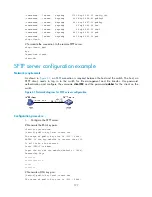
200
Configuring SSL
SSL is a security protocol that provides secure connection services for TCP-based application layer
protocols such as HTTP. It is widely used in e-business and online banking to ensure secure data
transmission over the Internet.
SSL security mechanism
Secure connections provided by SSL have these features:
•
Confidentiality
—SSL uses a symmetric encryption algorithm to encrypt data and uses the
asymmetric key algorithm of RSA to encrypt the key to be used by the symmetric encryption
algorithm.
•
Authentication
—SSL supports certificate-based identity authentication of the server and client by
using the digital signatures. The SSL server and client obtain certificates from a CA through the PKI.
•
Reliability
—SSL uses the key-based MAC to verify message integrity (see
). A MAC
algorithm transforms a message of any length to a fixed-length message. With the key, the sender
uses the MAC algorithm to compute the MAC value of a message. Then, the sender suffixes the
MAC value to the message and sends the result to the receiver. The receiver uses the same key and
MAC algorithm to compute the MAC value of the received message and compares the locally
computed MAC value with that received. If the two values match, the receiver considers the
message intact; otherwise, the receiver considers that the message has been tampered with in
transit and discards the message.
Figure 63
Message integrity verification by a MAC algorithm
For more information about symmetric key algorithms, asymmetric key algorithm RSA, and digital
signatures, see "
For more information about PKI, certificate, and CA, see "
SSL protocol stack
The SSL protocol consists of two layers: the SSL record protocol at the lower layer and the SSL
handshake, change cipher spec, and alert protocols at the upper layer. See
.
Содержание A5830 Series
Страница 207: ...199 Figure 62 SFTP client interface ...
















































